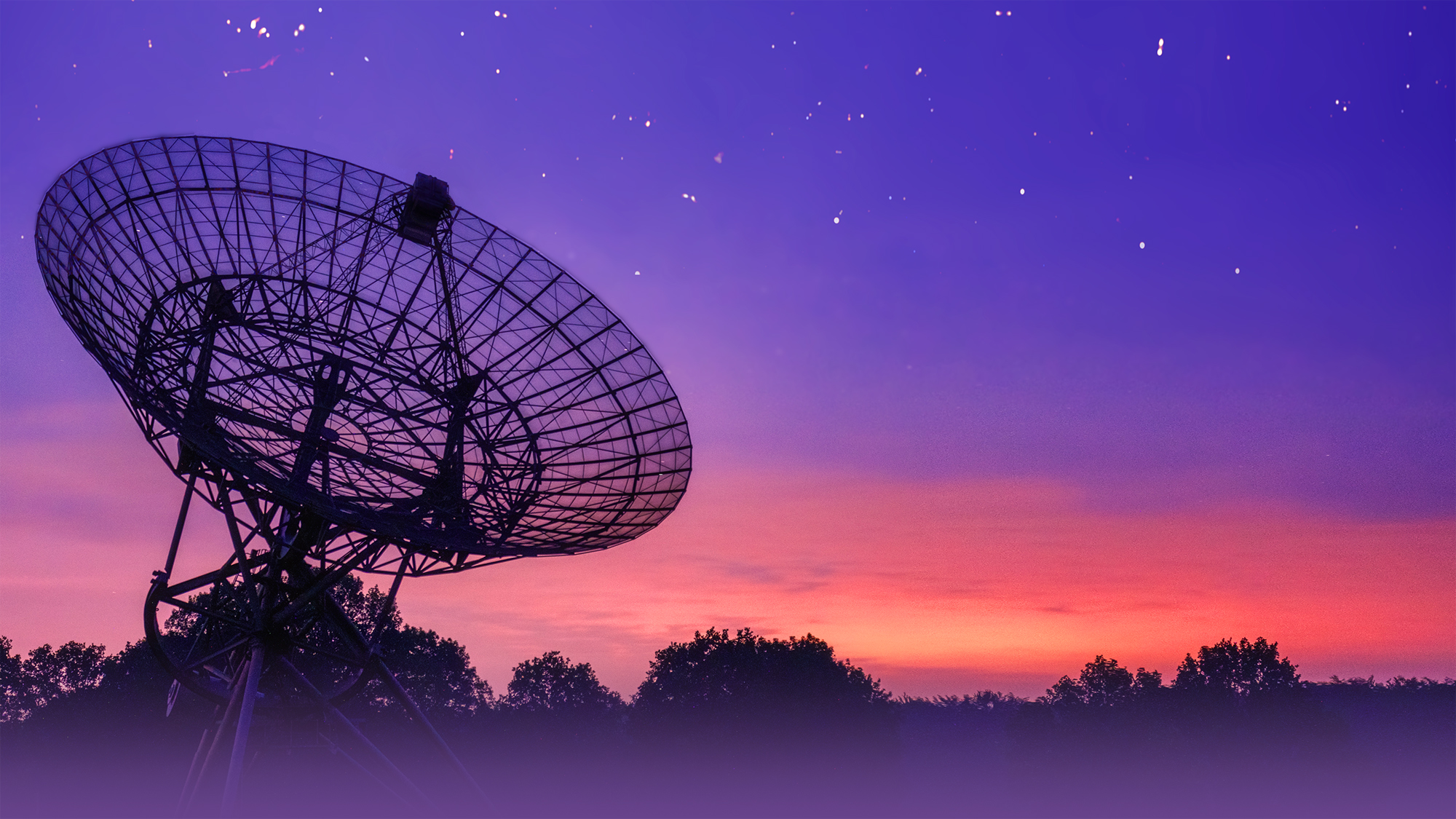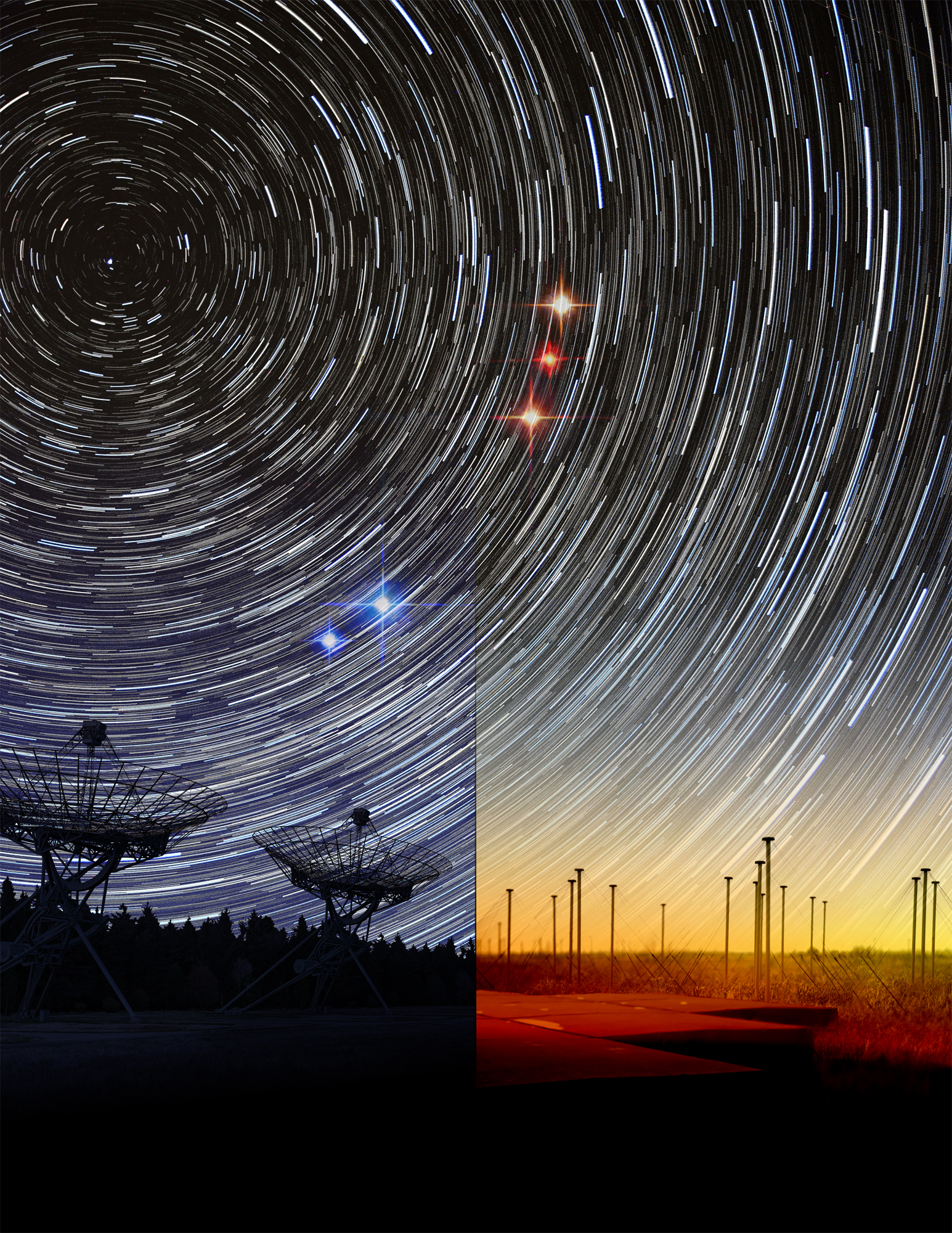'Radio colors' from mysterious deep-space flashes reveal lone stellar corpse as source
The "fast radio bursts" did not come from a binary pair of objects as previously thought.

Mysterious repeating pulses of radio waves may come from a hitherto unknown kind of extraordinarily powerful cosmic magnet, and not pairs of stars as previously suggested, a new study finds.
Fast radio bursts, or FRBs, are powerful pulses of radio waves that can release more energy in a few thousandths of a second than the sun does in nearly a century. Astronomers only discovered FRBs in 2007, and because the bursts are so brief, much remains unknown about them.
Since fast radio bursts are rare and bright, researchers have often assumed they generally originate from cataclysmic events, such as stellar flares or colliding neutron stars. (Neutron stars are remnants of stars that died in catastrophic explosions known as supernovas; the gravity of these stellar corpses is powerful enough to crush protons and electrons together to form neutrons.)
The mystery of fast radio bursts deepened when scientists discovered the first repeating fast radio burst in 2016. When astrophysicists see repeating patterns in celestial events, they often think celestial mechanics might play a role — say, a planet completing an orbit around its star, or a spinning neutron star blasting out radio waves from its magnetic poles, flashing like a lighthouse from the perspective of Earth.
Related: Scientists paint best yet portrait of closest known fast radio burst
In the new study, scientists focused on FRB 20180916B, which was discovered in 2018 and explodes with a fast radio burst about every 16.35 days. The regular nature of such a cycle led previous research to construct models in which the repeating bursts come from a binary system — a powerful source of radio waves such as a neutron star orbited by a companion such as a giant star or another neutron star.
One key consequence of these binary scenarios would have to do with the "color" of the radio waves from the repeating bursts. When it comes to visible light, shorter wavelengths are bluer, whereas longer wavelengths are redder. If the source of repeating fast radio bursts was a binary system, previous research suggested that powerful stellar winds of energetic particles from the fast radio burst's source should let more blue radio light escape the system but block most or possibly all of the redder radio waves.
Get the Space.com Newsletter
Breaking space news, the latest updates on rocket launches, skywatching events and more!
"Those models seemed to be the most likely scenario before our observations," study lead author Inés Pastor-Marazuela, an astrophysicist at the University of Amsterdam and at ASTRON, the Netherlands Institute for Radio Astronomy, told Space.com.
In the new study, Pastor-Marazuela and her colleagues tested this colorful idea by combining two of the biggest radio telescopes in the world — the Low-Frequency Array (LOFAR) located mainly in the Netherlands, and the Westerbork Synthesis Radio Telescope (WSRT) in the northeastern Netherlands. This helped them analyze bursts from FRB 20180916B at redder and bluer radio wavelengths at the same time.

Unexpectedly, the researchers saw two days of bluer radio bursts, followed by three days of redder radio bursts. This ruled out the simple binary system models, suggesting that something else was happening, Pastor-Marazuela said.
Instead, what may best explain the pattern of mysterious colors from FRB 20180916B's fast radio bursts is a magnetar, a rare type of neutron star that are the strongest magnets in the cosmos. Specifically, they suggest that an isolated, slowly rotating magnetar may best explain their findings, one that completes a spin about every 16 days, Pastor-Marazuela said.
However, scientists have not yet detected any magnetar that spins that slowly. "With our current knowledge, it's very hard to understand how such magnetar could exist," Pastor-Marazuela said, as powerful magnetic fields are often linked with high rates of spin. "But so far, there are no other models that fit our observations as well as the slow magnetar."
These findings suggest that some fast radio bursts may be free of any shrouding material, such as a dense cloud of electrons, to obscure all the colors of their outbursts. Such "bare" fast radio bursts could help researchers solve a major scientific puzzle — the location of half the universe's baryonic, or "normal" matter.
The kind of matter that makes stars, galaxies and planets and so on is called "baryonic" matter, because it is mostly made of particles known as baryons, which include the protons and neutrons that make up atomic nuclei. However, for decades, astronomers are only able to account for about half the universe's predicted baryonic matter.
Last year, scientists revealed fast radio bursts may help solve the missing baryon problem. As the radiation from fast radio waves pass through clouds of hidden baryonic matter, the redder radio waves are more likely to get slowed than the bluer ones. By analyzing the different times at which redder and bluer signals from fast radio bursts reach Earth, researchers can estimate how much baryonic matter the radio waves passed through along the way.
If all fast radio bursts are bare, it will be much easier to use them to measure the universe's baryonic matter in the Universe, as scientists will not have to account for how their immediate surroundings might skew baryon estimates, Pastor-Marazuela said.
The scientists detailed their findings online Aug. 25 in the journal Nature.
Originally published on Space.com.
Join our Space Forums to keep talking space on the latest missions, night sky and more! And if you have a news tip, correction or comment, let us know at: community@space.com.

Charles Q. Choi is a contributing writer for Space.com and Live Science. He covers all things human origins and astronomy as well as physics, animals and general science topics. Charles has a Master of Arts degree from the University of Missouri-Columbia, School of Journalism and a Bachelor of Arts degree from the University of South Florida. Charles has visited every continent on Earth, drinking rancid yak butter tea in Lhasa, snorkeling with sea lions in the Galapagos and even climbing an iceberg in Antarctica. Visit him at http://www.sciwriter.us









